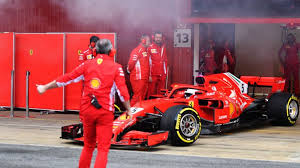There was an unusual phenomenon during winter testing – the smoking Ferrari SF71-H. Every time the Scuderia’s new car left the team’s garage it trailed a plume of oily smoke, which wafted across the Circuit de Catalunya pit lane. So what exactly was going on – and why? “It’s there to accommodate an oil breather. “Breathers are essential parts of any power unit on every car, but this year they’ve been subject to a new rule which says they must vent to the outside and cannot be routed back into the engine. This suggests teams were doing that previously which could have given them a power boost – but anyway, what is unusual, is that these Ferrari-engined cars are spewing out more oil than Renault or Mercedes-engined cars.
“There’s a fine mist of oil coming out the Ferrari, Haas and Sauber’s vents when out on track or even just when they are going down the pit lane. “You could notice it, for instance, on the test two, day one edition of Ted’s Notebook. “It was abundantly clear whenever Sebastian Vettel fired up in the garage because a huge plume spilled out of the garage. “Asking around, it seems to be that the Ferrari engine simply uses an awful lot more oil than its rivals. It is, though, a different thing to oil burning which is now limited to 1.8 litres per race. That’s oil that gets consumed within the combustion chamber. This is just used engine oil – a lot of it! “The phenomenon of the smokin’ Ferraris will be one to watch out for when racing starts.”
The phenomenon is a cause of regulation change. In the season 2017 teams mixed oil to the petrol improve performance of cars. Now regulations ban this, so burning motor oil is now forbidden. When a combustion engine runs, the crankcase fills up with oil smoke. Up until now a so-called breather valve has been used to channel the oil next to the intake manifold. So the oil smoke from the engine has been reburnt, and performance enhancing ingredients can no longer be added to the motor oil.
















